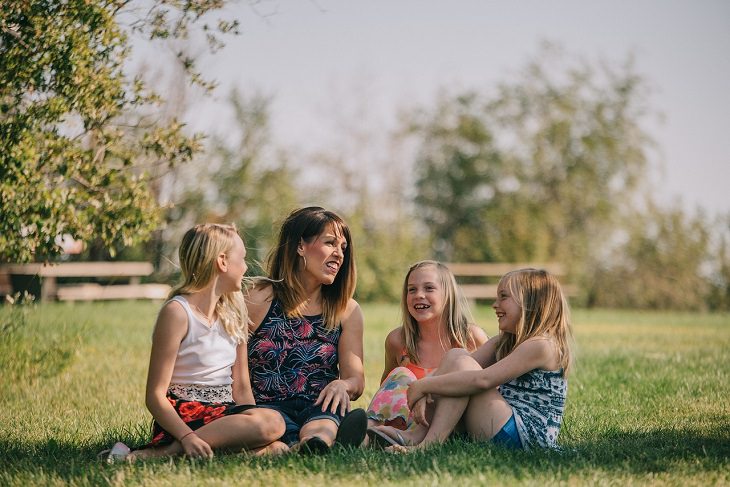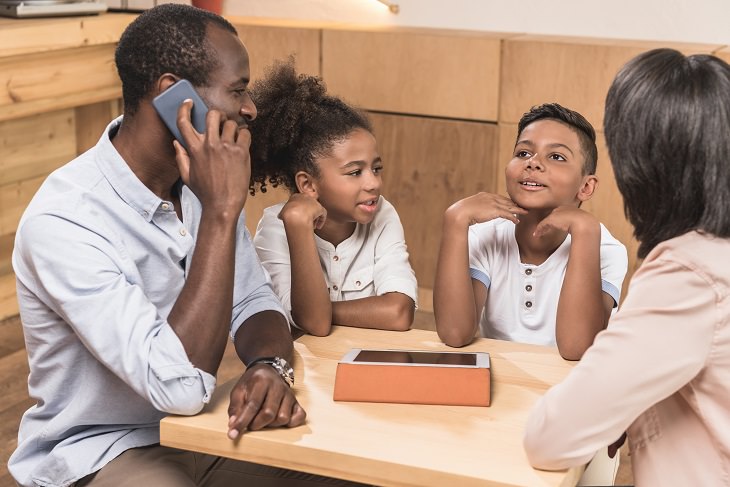
What we love most about winter in general, and the holiday season in particular is that we spend more time together as families. Sometimes, stressors of the day can get in the way, and you can't navigate your worried mind back into the family conversation. Or perhaps, the kids all run away to their gadgets as soon as they finish eating dinner. How do we bring back optimal communication and family fun? With games, of course!
The following games are verbal games - they don't require any accessory but your mind. Some might require some pen and paper, but really, all you need is a little enthusiasm, some imagination, and as much company as you can get! These games can also be played long distance, over the phone, or on a video call.
In fact, they can be quite the learning activity, and you can play them absolutely anywhere; while on walks, during car rides, and even when visiting places. From classic childhood games to insightful and interesting challenges, these conversation games will make any date, dinner, and zoom call unforgettable fun!

This game is a light, enjoyable way to bond with the kids. It’s a fast-paced associations game, so it easily engages the players, which must stay alert! You start by picking a general category, like books, sports, TV shows, food, or even places and superheroes.
The game is played with a lightning round of questions asking about a player's preference for two things that fall under the selected category. Each round is played with two people, where one asks the questions and the other answers. Every subsequent question should contain the previous question's preferred item.
Q: “What’s better, cheese or candy?”
A: “Candy”
Q: “What’s better, candy or ice cream?”
A: “Ice cream”
Q: “What’s better, ice cream or cookies?”
The most important rule is - the faster, the better. You'll be surprised at all the giggles this creates! The "asker" has to keep thinking of new questions and the "answerer" has to listen attentively. The round ends when an answer or question is delivered too slowly.
Picking the topic can also be a fun activity with a group, giving everyone an opportunity to submit their suggestions and debate them. “What’s Better” is a fun and simple way to gain insight into different people's preferences, young and old alike.

“Fact or Fiction” is an entertaining and engaging way to expand your mind while testing your knowledge and the knowledge of everyone playing with you. Like “What’s Better”, it can be played by two or more players.
Every participant will look up myths and legends as well as actual facts related to a particular topic. Each player can choose their own topic, or everyone can work on the same topic together. It can be anything from significant events, important monuments, different cultures, or ancient history. Here are some examples to get you started: The French Revolution, the animal kingdom, or American National Parks. Each turn, a player says either a fact or a myth, and other players must guess which it is.
Topic: Animal Kingdom
Player 1: Fact or Fiction? Grizzly bears can run as fast as horses.
Player 2: Fact or Fiction? Flamingos are pink because they eat shrimp
Player 3: Fact or Fiction? Bulls hate the color red
The game will end when you run out of facts or myths. It can also be played in multiple rounds with a single person stating all the possible legends or facts under a particular category, and other players guessing for each round.
“Fact or Fiction” is a wonderful way to learn new things and even spark new interests in different subjects, making it a great game for kids. You can award points to the player that gets the most number of correct guesses and select a grand prize winner at the end of the game.
An alternative way to play
If you want to make this game a little more personal, each player in their turn can present a little-known fact or made-up fact about themselves. Then the rest will try to guess if it's fact or fiction! This is a great icebreaker or a fun way to get to know your companions. Here's how it goes:

You can adjust the difficulty level of this game, depending on whether you're playing it with young kids, teenagers, or adults. The premise of the game is simple. On each turn, the player lists a set of three or four items. In each set, one is the odd one out. The other player(s) must guess which is it.
Easy: Cat, Dog, Book.
A: Book - Cats and dogs are living things while a book is a non-living thing.
Medium: Train, Car, Boat.
A: Boat - Train and car are vehicles of land while a boat is a water vehicle.
Hard: Frog, Cow, Human, Monkey.
A: Frog - Cows and humans are mammals while frogs are amphibians.
Extra Hard: 53, 68, 79, 91.
A: 68 - 53 and 79 are prime numbers while 68 is not.
Much like “Fact or Fiction”, presenting the sets can be done by one person conducting the round, or it can be done by each player in turns. The subject of each set can be changed at each turn to make the game extra challenging. Points can be awarded for every correct guess of the odd one out, with a final winner being declared at the end of the game.
Need some inspiration for combinations? Here's a food-themed one:

This verbal game will take you back to cross-country road trips in an old-school RV. Back in the day, there was no built-in entertainment system. Instead, we played either “Name, Place, Animal, Thing”, or 3,000 rounds of “I Spy”. “Name, Place, Animal, Thing” is a fun, challenging way to get those brains revving.
The game is played in multiple rounds (but never quite as many as “I Spy”) and can be played with multiple players. In each round, a letter of the alphabet is randomly selected. As soon as the selected alphabet is announced, all players have a certain amount of time to list a name, a real place, an animal, and an inanimate object all of which must begin with the selected letter.
Selected letter: G
Name: Gary
Place: Geneva
Animal: Gecko
Thing: Gazebo
To make the game harder, remove the letters you already used from the next rounds. Alternatively, keep using all the letters you used and try to find new answers each time you get them. To add some spice, you can time each round. The shorter the time, the harder it gets!
Points can be awarded either on the basis of the total number of words each player found within all rounds, or the number of completed rounds (where all 4 categories have been filled). Each player can keep track of their answers in a written table.

Here’s a game that will not only test your memory but also might help you update your grocery list! The first player starts by saying: "I went to the market and bought a _____". Each player has to recite the previous player's grocery list, and add one item of their own.
Player 1: I went to the market and bought a loaf of bread.
Player 2: I went to the market and bought a loaf of bread and bananas.
Player 3: I went to the market and bought a loaf of bread and bananas and a candy bar.
Player 4: I went to the market and bought a loaf of bread and bananas and a candy bar and shoe polish.
The aim is to challenge and develop memory, quick thinking, and creativity. The items must be real. For a real challenge, replace the market with the Zoo, and list only animals. The round ends when a player either forgets previous items or is unable to list a new one. The winner, declared at the end of each round, is the player with the least number of losses.
Watch this lovely family play their version of the game:

"Word Tennis" will put your vigilance to the test! As the name suggests, the game format is a quick lightning round. It is for 2 to 4 players. There are two versions of this game that can be played. The first is called “Sound Tennis” and the second is called “Rhyming Tennis”.
In “Sound Tennis”, either a sound or letter is chosen at random by the oldest member of the group. For example, the letter “P” or the sound “Sh”. Each player must then say a word starting with the selected sound or letter in rapid succession.
Selected Sound: Sh
Player 1: Sheep
Player 2: Shock
Player 3: Shot
In “Rhyming Tennis”, a similar concept is applied to rhyming words. You first select the suffix (“at”, “ay” or “ess”). Then each player lists out words from that family in a quickfire round.
Rhyming Family: Ay
Player 1: Stay
Player 2: Fray
Player 3: May
Important rules: You can't repeat a word that was already said. The round ends when a player runs out of words to add to the chain. The player with the least number of losses or the highest number of wins at the end of the game is the final winner.

This game is where all great public speaking skills come out. It can be played with just 2 people but it's best suited for a larger group. The rules of this game are very simple: Every turn, a player is given a topic. They must speak on that topic for just a minute. Sounds easy enough, right? Well, it's not THAT easy...
The challenge is to select relatively obscure or unknown topics, those that don't cross your mind on a daily basis. These topics could range from math or astronomy to the Bermuda Triangle or the extinction of mammoths. If you don't know a single thing about the topic you're given, you can improvise made-up facts. The laughs are guaranteed!

This is a classic we're sure you've heard of before. Most chances you also played it too. In this verbal game, one player asks their companion what would they rather have between two choices. This game is an invitation to explore the weirder edge of the scale.
"Would you rather have super-strength or super-flexibility?"
"Would You rather live underwater or in outer space?"
If you like a challenge, add a condition to each one:
"Would you rather be able to speak with animals, but never be able to disclose what they say, or be able to fly, but never be able to swim again?"
"Would you rather be able to breathe underwater but never enjoy chocolate cake again, or have unlimited funds for your every wish but must wear jeans to sleep every night?"
The stranger it gets, the better!

"The alphabet game" is a brain-strain for every age. Pick a topic (like cities, countries, garments, foods, colors, numbers, fabrics). Each player must list an item that fits in the category. The first will start with the letter A, the second with the letter B, and so forth.
Topic: garments
Player 1: Apron
Player B: Bra
Player C: Cardigan

In this game, fit for two or more players, one player chooses a physical object they think about and the others have to guess what that is. It has to be something material (can't be a concept, idea, memory, or ideology). The rest of the players can only ask yes-or-no questions to try and find out the object. They can only ask up to 20 questions. The more obscure and rare the object is, the more challenging the game becomes. The winner is either the group, if they guessed it in less than 20 questions, or the player if the group failed!
We chose a hat.
Q: "Is it a piece of furniture?"
A: No.
Q: "Is it a garment?"
A: Yes.
Q: "Is it for winter?"
A: Yes.
Q: "Is it a coat?"
A: No.

Another classic, this game can be played as a pair but it is much more engaging as a group. Each player gets assigned a real or fictional character. The objective of the game, similar to "20 Questions", is to find out which character is using only yes-or-no questions.
We chose Abraham Lincoln, under the category of Historical Figures.
Q: "Am I a fictional character?"
A: No.
Q: "Am I alive?"
A: No.
Q: "Am I male?"
A: Yes.
Q: "Am I an artist?"
A: No.
You can ask as many questions as you like. Here's how it goes:

Another classic game, charades is also about guessing, but this time, the player can't say a word! You might ask, is "Charades" really a verbal game then? Well it is, and one of the oldest. You probably already know the rules, but here they are:
The objective is to communicate an idea successfully through pantomime. Divide into two groups. Every player writes something to be portrayed in pantomime on a note. This can be a song title, a movie or theatre title, a well-known quote or phrase, a book title, or a TV show.
Gather all the notes in a bowl. Everyone sits down while one player pulls out a note from the bowl. They must keep it hidden. The player then has to try to communicate what's written on the note through gestures alone, no voices allowed!
If one from the player's group guesses the correct answer first, they get a point. If the opponent group gets it first, no one gets a point. Here are some examples of the gestures:

This is a verbal game for larger groups containing at least four players. One player leaves the room while the rest agree on a topic that will be the common factor of everything they bring to the party. Once they agree, they invite the other player back in and start listing, one in each turn, what they bring to the party. The player who went outside must guess the common factor.
The common factor is size - everything you bring to the party must be larger than the human scale.
Player 1: "I am bringing an elephant to the party".
Player 2: "I am bringing a skyscraper to the party".
Player 3: "I am bringing a mountain to the party".
The guesser can guess anytime. They have 5 guesses - so make it hard on them!
Share this and let everyone join in on the fun!